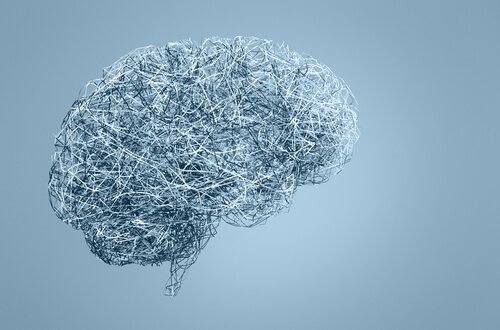Neurosexism: The Supposed Brain Differences between Men and Women

Some studies claim that there are important differences between men and women’s brains. This is what neurosexism is all about. It states men and women’s brains have different sizes and shapes.
These studies are based on neuromyths, which people often use to point out the supposed brain differences between men and women. Curiously enough, the neuroscience community has contributed to and supports them. In fact, only few people, most of them women, have dared to question those myths.
Let’s reflect on Professor Sonia Reverter-Bañón’s critical opinion on neurosexism.
Critical Thinking vs. Neurosexism
Reverter-Bañón has talked about a very curious anecdote in her work. In 1915, a neurologist called Charles Dana voiced his opinion on women’s right to vote in The New York Times: “If women achieve the feminist ideal and live like men, they’ll be 25% more likely to suffer from dementia.”
But on what evidence did he base his opinion on? According to him, women’s upper backbone, which controls the limbs and pelvis, is smaller than men’s and that it affects women’s efficiency to evaluate political initiatives. That’s why, according to him, voting could endanger women’s health.
According to Professor Reverter-Bañón, that opinion results from “pseudoscientific thinking”. With this term, she refers to the scientific community’s contribution to dangerous and judgmental beliefs. And Dr. Dana is the perfect example of what the scientific community has established as “obvious” for many years: the differences between men and women’s nervous system.

Neuromyths and Neurosexism
According to OECD (2002), a neuromyth is a misconception. In other words, it’s an inaccurate interpretation or “deliberate deformation” of scientific facts.
The term neurosexism itself is a neologism. It tries to label all ideas and theories that use neuroscientific research to reinforce the belief that men and women’s brains are different. In fact, it was first used by Cordelia Fine in 2008. Then, it became popular with the release of her book Delusions of Gender: How Our Minds, Society, and Neurosexism Create Difference (2010).
Thus, neurofeminism was born to fight neurosexism. Neurofeminism claims that the hypothesis that men and women’s brains are different is based on false results, bad methodologies, unproven assumptions, and premature conclusions. Also, scientists often ignore how profound the female mind. And finally, neurofeminism claims that prejudice and biases affect results.
But when it comes to studying brain sexual differences, the following questions have a huge impact:
1. Confusion of the Terms “Sex” and “Gender”
According to Reverter-Bañón, gender is the main element of role continuity and can be patriarchal or not.
In general, it’s clear that gender is part of the sex duality. However, this doesn’t take into account some terms such as “transgender” and “intragender”.
Sonia also explains that it’s necessary to analyze sex research. Because is there really a scientific explanation as to why our society separates sexes into two different “roles” and raises people in a certain way depending on it?

2. Lack of Evidence and Bias
As some authors and metadata studies have confirmed, supposed scientific evidence can’t lead to scientifically verified conclusions that there are brain differences between men and women. C. Vidal (2011) expressed some ideas about this:
- Brain differences in a small sample group aren’t statistically determinant. Evidence shows that when there’s a great number of analyzed individuals, brain differences are insignificant. This is due to how the brain changes from person to person, no matter the sex.
- Important results were usually obtained in artificial laboratory contexts.
- When it comes to fMRI, scans simply provide a static image of a specific brain state. This can’t be considered direct evidence that biological factors or cultural processes change the brain’s state.
Some studies claim that there are important differences between men and women’s brains. This is what neurosexism is all about. It states men and women’s brains have different sizes and shapes.
These studies are based on neuromyths, which people often use to point out the supposed brain differences between men and women. Curiously enough, the neuroscience community has contributed to and supports them. In fact, only few people, most of them women, have dared to question those myths.
Let’s reflect on Professor Sonia Reverter-Bañón’s critical opinion on neurosexism.
Critical Thinking vs. Neurosexism
Reverter-Bañón has talked about a very curious anecdote in her work. In 1915, a neurologist called Charles Dana voiced his opinion on women’s right to vote in The New York Times: “If women achieve the feminist ideal and live like men, they’ll be 25% more likely to suffer from dementia.”
But on what evidence did he base his opinion on? According to him, women’s upper backbone, which controls the limbs and pelvis, is smaller than men’s and that it affects women’s efficiency to evaluate political initiatives. That’s why, according to him, voting could endanger women’s health.
According to Professor Reverter-Bañón, that opinion results from “pseudoscientific thinking”. With this term, she refers to the scientific community’s contribution to dangerous and judgmental beliefs. And Dr. Dana is the perfect example of what the scientific community has established as “obvious” for many years: the differences between men and women’s nervous system.

Neuromyths and Neurosexism
According to OECD (2002), a neuromyth is a misconception. In other words, it’s an inaccurate interpretation or “deliberate deformation” of scientific facts.
The term neurosexism itself is a neologism. It tries to label all ideas and theories that use neuroscientific research to reinforce the belief that men and women’s brains are different. In fact, it was first used by Cordelia Fine in 2008. Then, it became popular with the release of her book Delusions of Gender: How Our Minds, Society, and Neurosexism Create Difference (2010).
Thus, neurofeminism was born to fight neurosexism. Neurofeminism claims that the hypothesis that men and women’s brains are different is based on false results, bad methodologies, unproven assumptions, and premature conclusions. Also, scientists often ignore how profound the female mind. And finally, neurofeminism claims that prejudice and biases affect results.
But when it comes to studying brain sexual differences, the following questions have a huge impact:
1. Confusion of the Terms “Sex” and “Gender”
According to Reverter-Bañón, gender is the main element of role continuity and can be patriarchal or not.
In general, it’s clear that gender is part of the sex duality. However, this doesn’t take into account some terms such as “transgender” and “intragender”.
Sonia also explains that it’s necessary to analyze sex research. Because is there really a scientific explanation as to why our society separates sexes into two different “roles” and raises people in a certain way depending on it?

2. Lack of Evidence and Bias
As some authors and metadata studies have confirmed, supposed scientific evidence can’t lead to scientifically verified conclusions that there are brain differences between men and women. C. Vidal (2011) expressed some ideas about this:
- Brain differences in a small sample group aren’t statistically determinant. Evidence shows that when there’s a great number of analyzed individuals, brain differences are insignificant. This is due to how the brain changes from person to person, no matter the sex.
- Important results were usually obtained in artificial laboratory contexts.
- When it comes to fMRI, scans simply provide a static image of a specific brain state. This can’t be considered direct evidence that biological factors or cultural processes change the brain’s state.
All cited sources were thoroughly reviewed by our team to ensure their quality, reliability, currency, and validity. The bibliography of this article was considered reliable and of academic or scientific accuracy.
-
Reverter Bañón, S. (2016). Reflexión crítica frente al neurosexismo.
-
Bem, S. L. (1983). Gender schema theory and its implications for child development: Raising gender-aschematic children in a gender-schematic society. Signs: Journal of women in culture and society, 8(4), 598-616.
-
Pallarés Domínguez, D. V. (2016). Neuroeducación en diálogo: neuromitos en el proceso de enseñanza-aprendizaje y en la educación moral.
-
Bañón, S. R. (2010). La deriva teórica del feminismo. Daimon Revista Internacional de Filosofia, 153-162.
-
Vidal, C. (2012). The sexed brain: Between science and ideology. Neuroethics, 5(3), 295-303.
- JORDAN-YOUNG, R. M. (2010), Brain Storm: The Flaws in the Science of Sex Differences. Harvard University Press.
-
Hyde, J. S. (2005). The gender similarities hypothesis. American psychologist, 60(6), 581.
-
Hyde, J. S. (2006). Gender similarities still rule.
-
Hyde, J. S. (2007). New directions in the study of gender similarities and differences. Current Directions in Psychological Science, 16(5), 259-263.
This text is provided for informational purposes only and does not replace consultation with a professional. If in doubt, consult your specialist.







